
Am Fam Physician. 2017;95(9):554-560
Author disclosure: No relevant financial affiliations.
Illness after recreational water activities can be caused by a variety of agents, including bacteria, viruses, parasites, algae, and even chlorine gas. These illnesses are more common in summer. Waterborne illnesses are underreported because most recreational activity occurs in unsupervised venues or on private property, and participants tend to disperse before illness occurs. Symptoms of waterborne illness are primarily gastrointestinal, but upper respiratory and skin manifestations also occur. Gastrointestinal symptoms are usually self-limited, and supportive treatment may be all that is necessary. However, some infections can cause significant morbidity and mortality. Cryptosporidium and Giardia intestinalis are the most common cause of gastrointestinal illness and have partial chlorine resistance. Respiratory infections are typically mild and self-limited. However, if legionnaires' disease develops and is unrecognized, mortality may be as high as 10%. Cellulitis caused by Vibrio vulnificus can result in serious illness, amputation, and death. Early and appropriate antibiotic treatment is important. Chronically ill and immunocompromised persons are at high risk of infection and should be counseled accordingly.
Approximately 40% of Americans swim recreationally, and many others have limited contact with water recreationally through canoeing and other activities.1 Outdoor recreation of any type puts persons at risk of sunburn, injuries, and infections due to incidental human contact. The presence of water adds the possibility of drowning or near drowning, with 3,300 deaths and another 5,000 hospitalizations annually.2 Additionally, a growing number of persons become ill from exposure to tainted water, whether from ingestion or other means. Man-made changes to the environment plus introduction of exotic species may increase the risk of infection.
| Clinical recommendation | Evidence rating | References |
|---|---|---|
| Clinicians should obtain an exposure history in patients presenting with symptoms that may be linked to waterborne illness, especially in the summer. | C | 3 |
| Persons with prolonged or recurrent diarrhea with potential exposure history should be tested for Giardia infection. | C | 8 |
| Patients with open wounds, diabetes mellitus, or chronic liver conditions should avoid swimming in brackish water because of the high risk of Vibrio vulnificus infection. | C | 30, 31 |
The Centers for Disease Control and Prevention (CDC) recently began tracking multiperson outbreaks associated with recreational waterborne activities. These data are voluntarily reported from all 50 states and U.S. territories. Annually, at least 2,000 persons contract disease in this manner, with about 10% of cases resulting in hospitalization.3 Although untreated ponds and rivers are often thought to be the culprit, a public pool or hot tub is more often the source.3 The incidence is higher in the summer because of increased recreational exposure (Figure 1).4 The true incidence is likely underreported because these illnesses tend to be self-limited, most recreational activity is on private property, and swimmers tend to disperse after exposure. The most common manifestation is gastrointestinal, but there are agents that cause pulmonary and skin manifestations as well. The symptoms are not specific to waterborne illnesses; waterborne pathogens should be suspected if symptoms coincide with water-based activity, especially in the summer.3 Table 1 identifies the most common symptoms of waterborne illness, initial management, and symptoms that require urgent disease-specific treatment in addition to supportive care.5–12
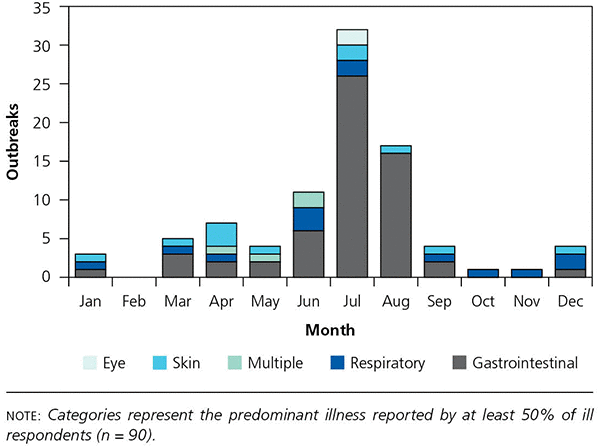
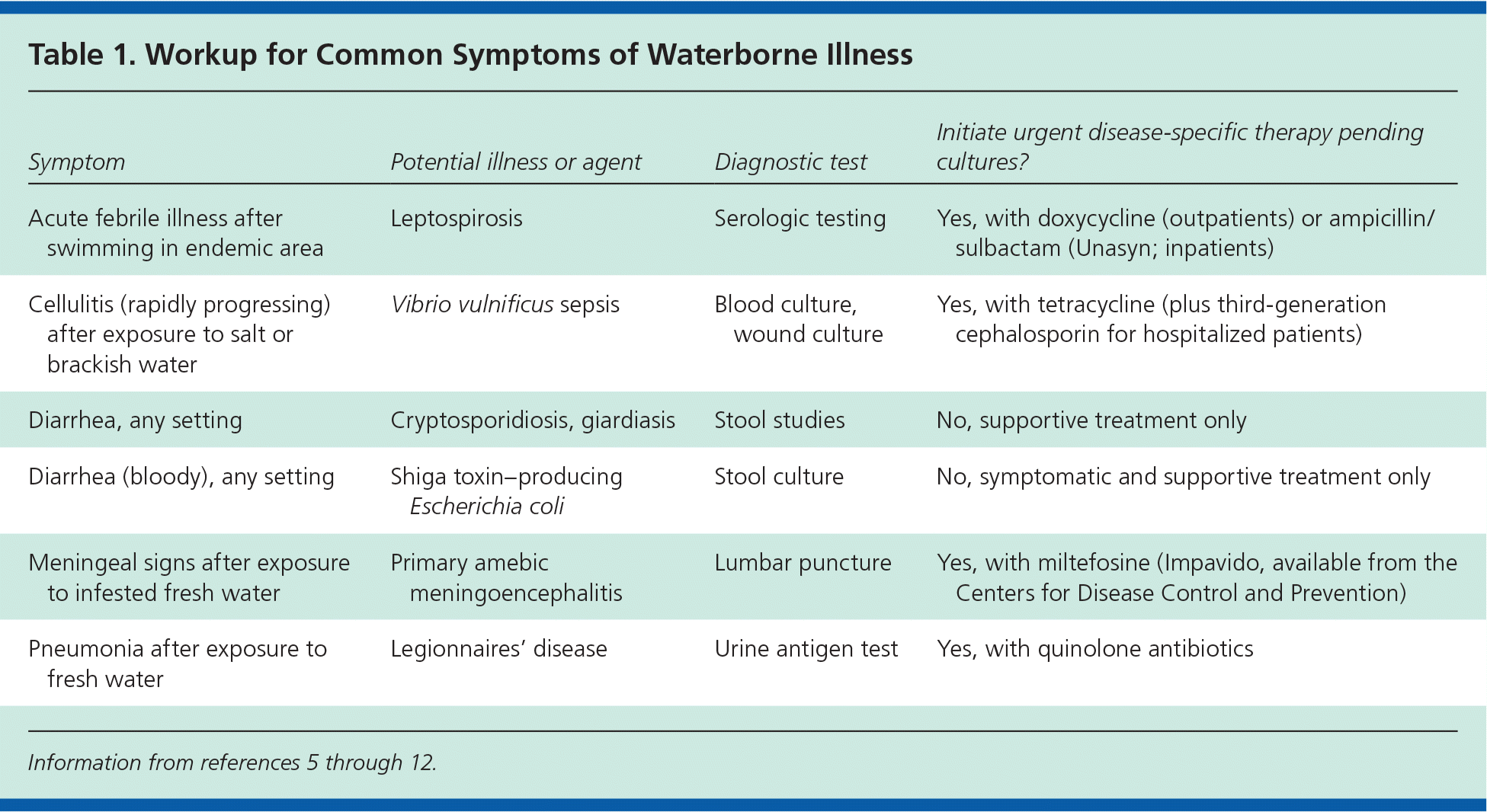
| Symptom | Potential illness or agent | Diagnostic test | Initiate urgent disease-specific therapy pending cultures? |
|---|---|---|---|
| Acute febrile illness after swimming in endemic area | Leptospirosis | Serologic testing | Yes, with doxycycline (outpatients) or ampicillin/sulbactam (Unasyn; inpatients) |
| Cellulitis (rapidly progressing) after exposure to salt or brackish water | Vibrio vulnificus sepsis | Blood culture, wound culture | Yes, with tetracycline (plus third-generation cephalosporin for hospitalized patients) |
| Diarrhea, any setting | Cryptosporidiosis, giardiasis | Stool studies | No, supportive treatment only |
| Diarrhea (bloody), any setting | Shiga toxin–producing Escherichia coli | Stool culture | No, symptomatic and supportive treatment only |
| Meningeal signs after exposure to infested fresh water | Primary amebic meningoencephalitis | Lumbar puncture | Yes, with miltefosine (Impavido, available from the Centers for Disease Control and Prevention) |
| Pneumonia after exposure to fresh water | Legionnaires' disease | Urine antigen test | Yes, with quinolone antibiotics |
Acute Gastrointestinal Illness
Common waterborne gastrointestinal illnesses are summarized in Table 2.13–16 Cryptosporidiosis and giardiasis account for more than 50% of all reported recreational waterborne illnesses.3 Cryptosporidiosis is caused by the apicomplexan protozoan Cryptosporidium. The ingested oocysts are the source of infection in humans and can survive for more than 10 days in water at CDC-recommended levels for chlorine (1 to 3 mg per L) and pH (7.2 to 7.8).9,17 Oocysts may be found in untreated recreational fresh water as well. Symptoms usually present within one to two weeks of exposure and are primarily diarrheal. It is diagnosed by a stool sample, increasingly using molecular methods. Management is primarily symptomatic; with fluid and electrolyte replacement the mainstay of therapy. Nitazoxanide (Alinia) may be used to treat severe or prolonged diarrhea. The cure rate with treatment is 72%.13 Regardless of treatment, shedding continues after symptoms abate, so once asymptomatic, patients should continue to refrain from swimming for two weeks.18 Nitazoxanide is not effective in immunocompromised persons, such as those with poorly controlled human immunodeficiency virus infection, so prevention is key.13
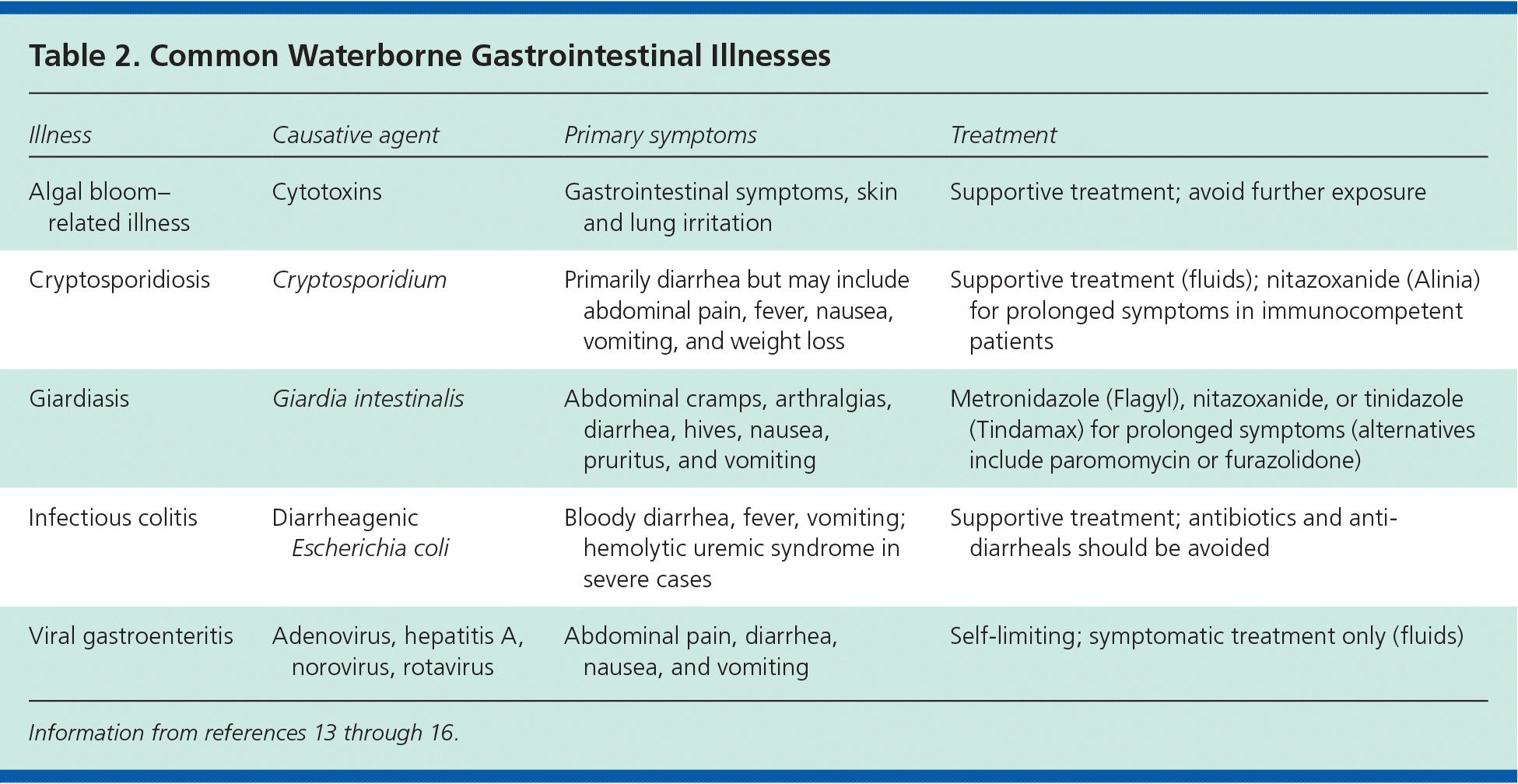
| Illness | Causative agent | Primary symptoms | Treatment |
|---|---|---|---|
| Algal bloom–related illness | Cytotoxins | Gastrointestinal symptoms, skin and lung irritation | Supportive treatment; avoid further exposure |
| Cryptosporidiosis | Cryptosporidium | Primarily diarrhea but may include abdominal pain, fever, nausea, vomiting, and weight loss | Supportive treatment (fluids); nitazoxanide (Alinia) for prolonged symptoms in immunocompetent patients |
| Giardiasis | Giardia intestinalis | Abdominal cramps, arthralgias, diarrhea, hives, nausea, pruritus, and vomiting | Metronidazole (Flagyl), nitazoxanide, or tinidazole (Tindamax) for prolonged symptoms (alternatives include paromomycin or furazolidone) |
| Infectious colitis | Diarrheagenic Escherichia coli | Bloody diarrhea, fever, vomiting; hemolytic uremic syndrome in severe cases | Supportive treatment; antibiotics and anti-diarrheals should be avoided |
| Viral gastroenteritis | Adenovirus, hepatitis A, norovirus, rotavirus | Abdominal pain, diarrhea, nausea, and vomiting | Self-limiting; symptomatic treatment only (fluids) |
Giardia intestinalis, an anaerobic flagellated protozoan, is the most common intestinal parasite in the United States. Almost one in 10 children becomes infected at some point during childhood, and adults are also susceptible.8 Infection occurs after ingestion of oocyst-contaminated materials by a susceptible host. A large number of oocysts (1 × 108 daily) are excreted by infected persons.14 Transmission through accidental ingestion can occur if a water source has been contaminated with feces from an infected person. Recreational fresh water is a highly effective means of transmission because of the ability of Giardia oocysts to survive for up to several months. In addition, oocysts are moderately chlorine resistant and can survive in treated swimming pools and hot tubs. Ingestion of a single oocyst can cause symptoms; conversely, about one-half of infected persons are asymptomatic.18 Symptoms, when present, occur within one to two weeks of exposure, are intermittent, and can recur after treatment.
Giardiasis is diagnosed via stool microscopy or antigen detection immunoassays. Parasite-specific real-time polymerase chain reaction testing is used to identify the Giardia subtype. At least three samples on different days are required because oocysts are often excreted intermittently. Shedding may last for several weeks, and symptoms may last for one to three weeks after infection. Infection rates are twice as high during summer. Giardiasis is often mild, and metronidazole (Flagyl) is effective in most patients, although some resistance has been noted.
Although viruses are commonly associated with gastrointestinal disease, they cause only about 10% of acute waterborne illnesses in the United States.3 Diarrhea caused by these viruses is typically mild and of short duration.3,15 Norovirus and adenovirus commonly cause waterborne illness; rotavirus and hepatitis A are less common etiologies. Viruses can survive in treated and untreated surface water and are somewhat chlorine resistant. Diagnosis is based on clinical suspicion, and treatment is symptomatic. Adenovirus strains 4 and 7 are most often associated with swimming pool–related diarrheal illness and can also cause common cold symptoms and conjunctivitis. Persons with acute conjunctivitis should avoid swimming until symptoms have resolved.
Escherichia coli is a bacterium found in the gastrointestinal tract of healthy humans and other mammals. Only certain strains are associated with diarrheal disease. In the United States, these diarrheagenic E. coli cause 10% of waterborne illnesses.6,7 Shiga toxin–producing E. coli, such as E. coli O157, is the most common pathotype and can make its way into recreational water via a person with diarrhea and incontinence (often a child) or into untreated water via livestock. Symptoms include cramping and bloody diarrhea. The disease is often self-limited, but severe dehydration can occur, necessitating rehydration therapy. Hemolytic uremic syndrome develops in 5% to 15% of cases.7 The incubation period ranges from one to 10 days, with most infected persons becoming symptomatic on day 3 or 4. Antibiotics and antidiarrheals increase the risk of hemolytic uremic syndrome and should be avoided. Diagnosis is made by stool assay for E. coli O157. If another strain is suspected, testing for Shiga toxins or the genes encoding these toxins should be ordered.15
Other bacterial pathogens that occasionally cause waterborne diarrheal illness include Shigella and Campylobacter.3,16 Under certain conditions cyanobacteria (blue-green algae) can overgrow, causing a harmful algae bloom. Ingestion of cytotoxins while swimming can cause acute gastrointestinal illness, as well as skin and lung irritation.19 Current recommendations are to heed public health warnings and avoid waters in active bloom. If exposure occurs, symptomatic treatment is warranted.
Acute Respiratory Conditions
Table 3 summarizes waterborne upper and lower respiratory illnesses.19–23 Upper respiratory symptoms are common after water activities, with more than 40% of recreational swimmers reporting sinus symptoms.20 Hyperemia from prolonged water exposure is the suspected etiology, and symptoms should resolve spontaneously. In addition, otitis externa is common in recreational swimmers and is for the most part self-limited.24 Topical antibiotics can shorten the course of illness. It is not known if prevention is possible. On rare occasions, bacterial sinusitis or otitis externa related to Vibrio alginolyticus25 or other unusual marine pathogens can occur. Prolonged or unusual symptoms should prompt further investigation, including culture of the affected site. Exposure to chemicals used in pool maintenance is another source of upper respiratory symptoms; these symptoms are usually self-limited.21
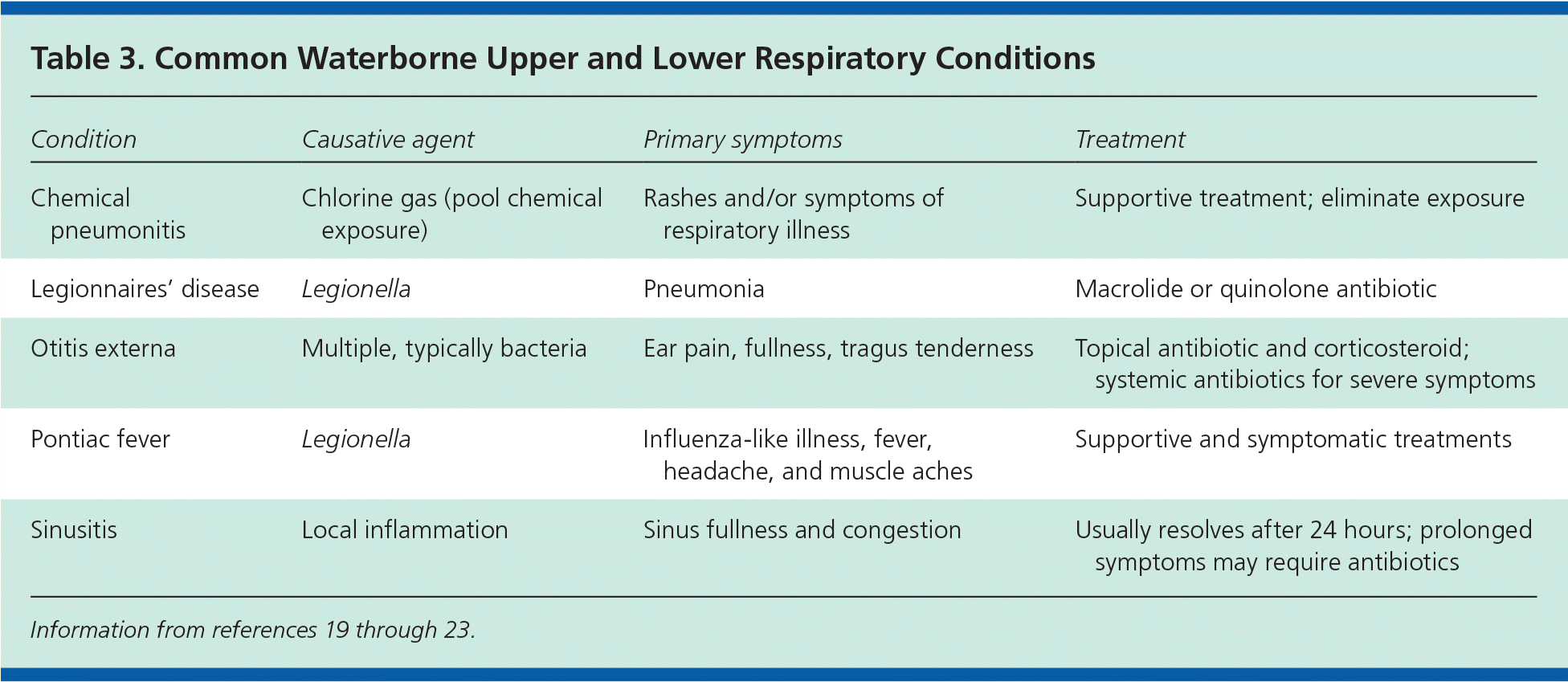
| Condition | Causative agent | Primary symptoms | Treatment |
|---|---|---|---|
| Chemical pneumonitis | Chlorine gas (pool chemical exposure) | Rashes and/or symptoms of respiratory illness | Supportive treatment; eliminate exposure |
| Legionnaires' disease | Legionella | Pneumonia | Macrolide or quinolone antibiotic |
| Otitis externa | Multiple, typically bacteria | Ear pain, fullness, tragus tenderness | Topical antibiotic and corticosteroid; systemic antibiotics for severe symptoms |
| Pontiac fever | Legionella | Influenza-like illness, fever, headache, and muscle aches | Supportive and symptomatic treatments |
| Sinusitis | Local inflammation | Sinus fullness and congestion | Usually resolves after 24 hours; prolonged symptoms may require antibiotics |
Legionella is a bacteria found in treated fresh water that can infect humans exposed to the aerosolized mist of hot tubs and decorative fountains. Infection can result in mild to severe illness.22,23 Mild illness (Pontiac fever) presents as an influenza-like syndrome and is self-limited. Treatment is supportive only. Severe infection resulting in pneumonia (legionnaires' disease) is life threatening, with a mortality rate of 10% if untreated.22 It is diagnosed via urine antigen testing; clinical suspicion is required. Because the test identifies only the most common serotype (about 80% of cases), a negative test should not rule out treatment if suspicion is high. Risk factors include a history of chronic lung disease and being older than 50 years or immunocompromised. A macrolide antibiotic (e.g., azithromycin [Zithromax]) is sufficient for outpatient treatment. For inpatient therapy, a respiratory quinolone is preferred. Sputum and blood should be obtained for culture before starting empiric antibiotic therapy. Nonresponse to treatment should warrant further investigation and/or referral to a subspecialist.
Primary amebic meningoencephalitis is a rare but deadly sinus-related infection caused by Naegleria fowleri.11 Although these amebae occur naturally in warmer fresh water (lakes, rivers, or hot springs), infections have occurred as far north as Minnesota. The amebae enter through the nasal cavity, so any activities in which the head is submerged pose a risk. Ingestion does not lead to infection. Approximately four infections per year are reported in the United States.26 Primary amebic meningoencephalitis has about a 90% mortality rate. If infection is suspected, the CDC should be contacted urgently; the agency can provide miltefosine (Impavido), an investigational drug used to treat this condition.
Acute Skin and Soft Tissue Conditions
Table 4 summarizes skin and soft tissue infections caused by waterborne agents.27–32 Hot tub folliculitis and dermatitis are common conditions caused by Pseudomonas aeruginosa.27 Treating the water does not mitigate risk because the warmer water renders the chlorine less effective. The rash typically occurs 48 hours after exposure and is usually more prominent in the areas that were covered with a swimsuit. Swimsuit removal after leaving the pool or hot tub seems to mitigate the effects. The rash usually resolves in a week with only symptomatic treatment. Persistent infections can be treated with a quinolone antibiotic.
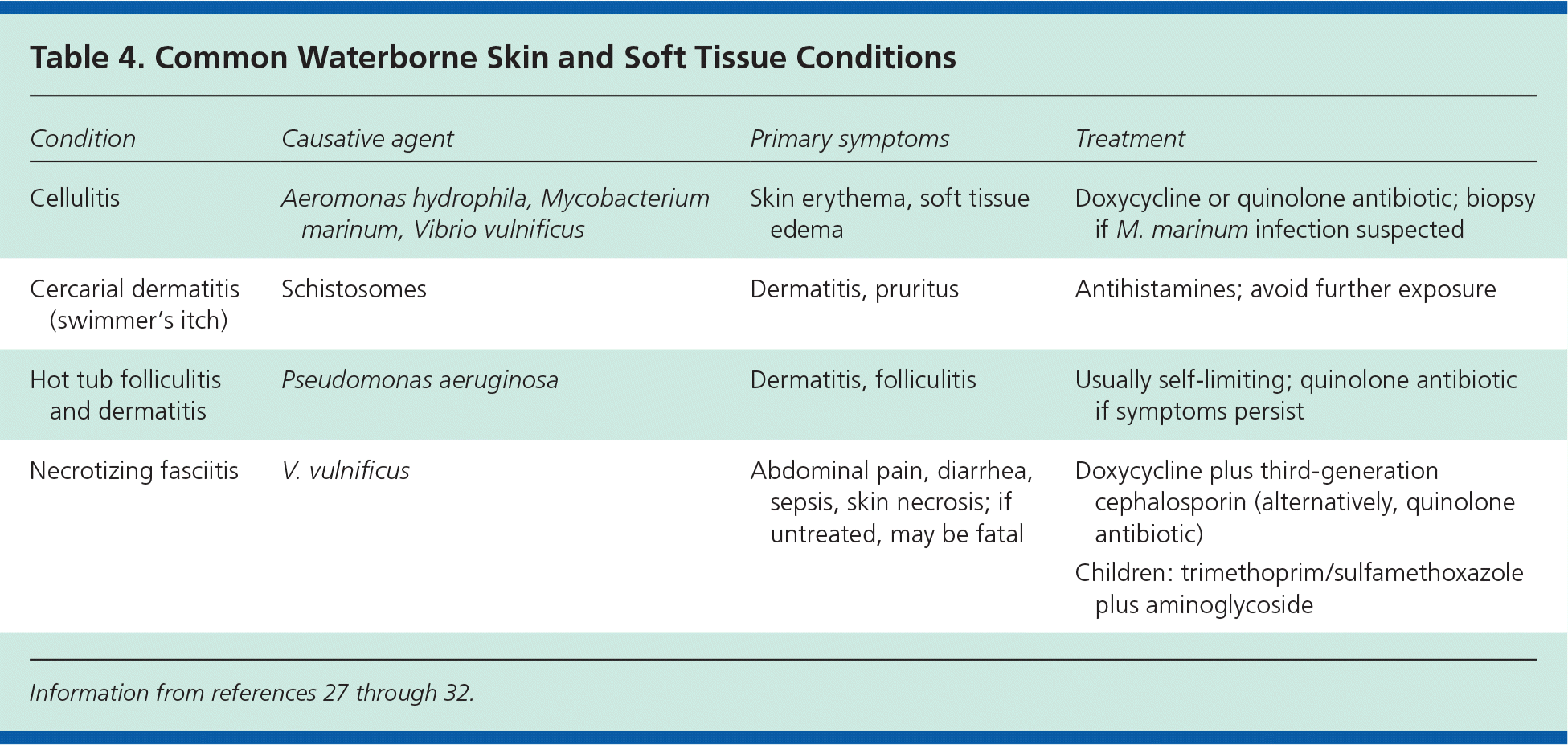
| Condition | Causative agent | Primary symptoms | Treatment |
|---|---|---|---|
| Cellulitis | Aeromonas hydrophila, Mycobacterium marinum, Vibrio vulnificus | Skin erythema, soft tissue edema | Doxycycline or quinolone antibiotic; biopsy if M. marinum infection suspected |
| Cercarial dermatitis (swimmer's itch) | Schistosomes | Dermatitis, pruritus | Antihistamines; avoid further exposure |
| Hot tub folliculitis and dermatitis | Pseudomonas aeruginosa | Dermatitis, folliculitis | Usually self-limiting; quinolone antibiotic if symptoms persist |
| Necrotizing fasciitis | V. vulnificus | Abdominal pain, diarrhea, sepsis, skin necrosis; if untreated, may be fatal | Doxycycline plus third-generation cephalosporin (alternatively, quinolone antibiotic) |
| Children: trimethoprim/sulfamethoxazole plus aminoglycoside |
Cercarial dermatitis (swimmer's itch) is caused by avian schistosomes whose life cycle includes one of several species of snail.28,29 The number of cases reported annually has increased as these hosts have spread into more U.S. regions. Several case studies show humans to be unsuitable hosts; thus, the parasites die after causing the dermatitis. Presentation is similar to any dermatitis, and diagnosis is based on clinical suspicion. It should be managed symptomatically.
Although cellulitis caused by Staphylococcus aureus and Streptococcus does occur, other pathogens such as P. aeruginosa and Aeromonas hydrophila are often implicated, and treatment decisions should reflect this.30 Serious infections can be caused by Vibrio vulnificus, a halophilic bacteria that thrives in warm, brackish environments. Infections are most common in the Gulf Coast states in the summer.31 Although infection is typically associated with severe illness after ingestion of raw infected shellfish by high-risk persons (e.g., those with liver disease or diabetes mellitus), soft tissue infection is a more common manifestation that may occur after a puncture, skin break, or wound is exposed under favorable conditions. If untreated, the infection can progress rapidly, potentially leading to necrotizing fasciitis. Once the infection is clinically suspected, blood and wound cultures should be obtained, followed by rapid initiation of a Vibrio-specific antibiotic, such as doxycycline. The mortality rate is high when treatment is delayed.32 Necrotic tissue should be debrided to control the infection, and limbs should be amputated if necessary. Persons with open wounds—especially immunocompromised persons and those with diabetes—should avoid exposure to brackish water to prevent infection.
Leptospirosis
Leptospirosis is an infection caused by a group of spirochetes known collectively as leptospires.33 They enter the body through mucous membrane exposure to or ingestion of contaminated fresh water. The water becomes contaminated via passage of the spirochetes from the urinary tract of an infected mammalian host. There are many different subtypes and many mammalian vectors. The spirochete can survive in water and soil for weeks to months without an animal host. The incubation period is between two days and four weeks. Clinical symptoms (headaches, chills, muscle aches, and jaundice) warrant a high index of suspicion, and early antibiotic treatment is indicated. If untreated, resolution may be followed by a second phase known as Weil disease.
Manifestations include meningitis, liver failure, kidney failure, and, in rare cases, death. Each year 100 to 200 cases and several deaths are reported in the United States, most often in tropical or temperate climates; 50% of cases occur in Hawaii.34 Exposure typically occurs during outdoor recreational activities such as camping and canoeing.35 Pets can become infected and are often asymptomatic. Preexposure prophylaxis is not effective for casual exposure, but if ongoing exposure is anticipated, pretreatment with 200 mg of doxycycline per week is safe and potentially effective.36,37 As of 2013, leptospirosis is a reportable disease in humans. Specimens should be sent via the state public health laboratory to the CDC's Zoonoses and Select Agent Laboratory.34
Prevention
The CDC has published the Model Aquatic Health Code, a comprehensive set of science-based and best practice recommendations to reduce the risk of illness and injury at public treated recreational water venues.38 The recommendations can be voluntarily adopted by state or local jurisdictions. Table 5 summarizes the recommendations that can be used to educate patients about prevention of recreational waterborne illnesses.38
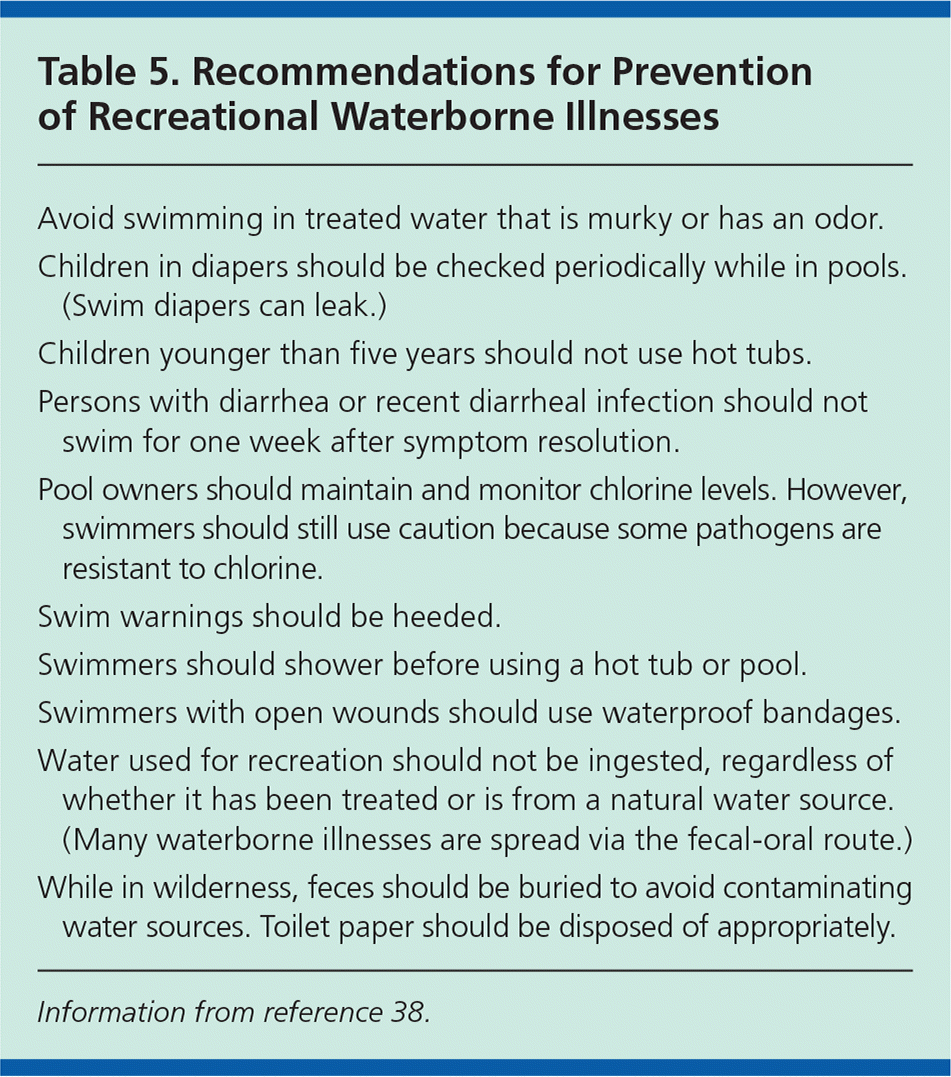
| Avoid swimming in treated water that is murky or has an odor. |
| Children in diapers should be checked periodically while in pools. (Swim diapers can leak.) |
| Children younger than five years should not use hot tubs. |
| Persons with diarrhea or recent diarrheal infection should not swim for one week after symptom resolution. |
| Pool owners should maintain and monitor chlorine levels. However, swimmers should still use caution because some pathogens are resistant to chlorine. |
| Swim warnings should be heeded. |
| Swimmers should shower before using a hot tub or pool. |
| Swimmers with open wounds should use waterproof bandages. |
| Water used for recreation should not be ingested, regardless of whether it has been treated or is from a natural water source. (Many waterborne illnesses are spread via the fecal-oral route.) |
| While in wilderness, feces should be buried to avoid contaminating water sources. Toilet paper should be disposed of appropriately. |
Data Sources: Essential Evidence Plus materials on the subject were reviewed. A PubMed search was completed initially using the key terms waterborne illness and recreational waterborne illness, and then in combination with specific causative agents. The search included meta-analyses, randomized controlled trials, clinical trials, and reviews. Also searched were the Agency for Healthcare Research and Quality evidence reports, Clinical Evidence, the Cochrane database, the U.S. Preventive Services Task Force website, the CDC Surveillance Resource Center, and UpToDate. Search dates: January 30, 2016, and February 7, 2017.
